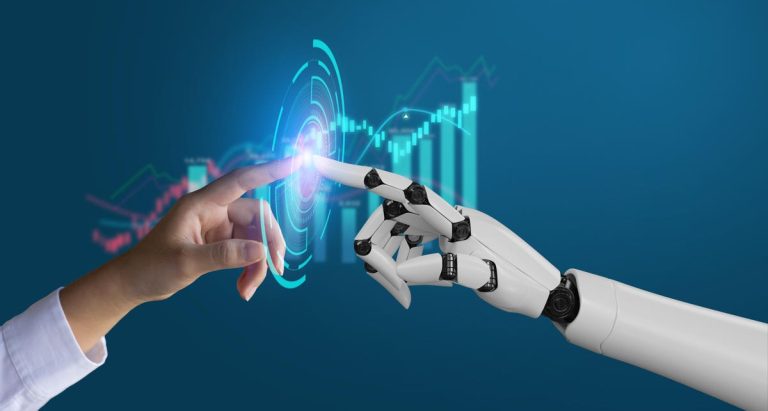Ever since ChatGPT arrived on the scene, nearly everyone has been obsessed—some terrified—by artificial intelligence (AI). Is all this excitement justified or is this just another shiny new object that investors will eventually discard? AI has already demonstrated that it can improve productivity, but is it also the ultimate disruptor that can threaten our very existence?
AI has been developing in various forms for years, but based on the current excitement about the field, one might think it is brand new. When ChatGPT surfaced early this year, conditions were perfect for saturation media coverage. Investors had already cycled through other “new things” such as cannabis, self-driving cars, cryptocurrency, meme stocks and the metaverse. I guess it was time for something new to focus on! Coverage and interest in AI increased exponentially in the investment community. As a measurable example, first quarter earnings conference calls this year logged in a huge count of the term “AI.” The second quarter’s count continues to grow. An analysis by Reuters revealed that over a third of S&P 500 companies mentioned AI in their earnings calls, compared to about a quarter in the first quarter. The terms “AI” or “artificial intelligence” were mentioned 827 times on 76 calls out of a total of 221 calls analyzed. This represents an average of 3.7 mentions per call, more than double the previous quarter. Why is the trend increasing?
In their earnings reports, companies from most industries are suddenly touting thinly described plans for AI to improve their operations and increase their earnings. No analysts dare press for details on the earnings conference calls either, because the new way to question companies is to flatter them, for fear of being blackballed. As a result, there are few real examples companies have offered to back up the claims. It appears that CEOs are pressured to be among the cool, forward-thinking crowd. Likewise, research analysts are pressured to “check the AI box” when writing their summary earnings reports. These issues regarding AI and corporations are important, but there is a more fundamental primal fear: Is AI—in its current state—close to modeling human thought successfully?
A certain subset of the general public perceives AI winds as harsh North winds, promising to replace us in our jobs, and eventually dismiss us humans in an adversarial way. To achieve this, the investment community generally believes that the path to modeling human thought (and greater profits somehow) is direct, but expensive: we just need more and more compute power to solve the challenge. On the other hand, I have talked with academic researchers that are experts in the field. They are neither personally invested in “AI stocks” nor do they have a financial incentive to spin the story. Simply put, they are appalled at the public’s perception of AI. Most experts cannot even agree on a basic definition of artificial intelligence. If no unified definition exists in the expert community, we are essentially at the very beginning of understanding the problem, rather than finding the solution. Given the lack of understanding the basics of AI, researchers think we are very far away from emulating human thought. What a disconnect between public perception and reality.
There are countless examples of AI infancy. If we want to create machines that think and mimic us, we need to know how we ourselves think and learn. (While this seems obvious, it is somehow lost on the masses.) Thus researchers are investigating how humans think and learn, and it’s a daunting process. They have made scant progress. But they can give countless timelines of what (not how) humans learn. The following chart is from a DARPA study on AI. Researchers measured what infants and toddlers can understand about the world around them—their “Cognitive Development Milestones for Children 0-18 Months Old”
Reviewing the chart, it is amazing that children as young as 2 to 4 months can realize that “unseen objects can cause visible outcomes.” Or that “objects move separately from one another except on contact.” When comparing these children’s skills to current state-of-the-art AI capabilities, the 4-month-olds currently win! If researchers knew how young children learn these things, that would produce a major breakthrough, providing great insight into formulating AI.
There are other simple mysteries about humans that computers just don’t get yet. “Easy tasks are hard, and hard tasks are easy” is a common phrase one hears around the research halls of AI. For example, a computer performs “hard” (to humans) tasks like sorting endless excel columns of data, but ask it to do something “easy” like play a game of charades and it flops. Indeed, the human thought process is virtually unknown. Simply throwing more compute power at the problem is likely not the answer.
I have some ideas about possible solutions. Borrowing from the history of physics, in the early 1900s an isolated, out-of-the-box thinker Albert Einstein solved problems that many scientists could not. (Years later he said his separation from the mainstream physics community probably played a role in his path to discovery.) Einstein’s solutions were considered outlandish until experiments proved him 100% correct.
Perhaps a similar situation will happen with AI. Some outsider may propose that we have all the computing power necessary, and the problem requires a different approach. Simple observations suggest this. For example, compare the pure geometry and energy efficiency of a human brain to AI physical configurations. Our brain size is tiny compared to the current racks of computer hardware that house tens of thousands of graphics processing units for AI. And on energy usage, ChatGPT used about 1300 megawatts of energy to train, and about 3.5 million liters of water. The adult human brain runs continuously, on only about 12 watts of power—-and a couple of glasses of water. It appears that relentlessly adding pure compute power is a very inelegant solution to the AI problem.
What are the alternatives for modelling human thought? Maybe computers need more structure, like a complete circulatory system to replicate a human circulatory system. (There is new evidence that human thought does not originate solely in the head but that it also depends on the entire human body). There are also researchers that are growing human brain cells on silicon chips, merging AI and synthetic biology in a new realm of continual machine learning. Or maybe we need to abandon the classical digital computer approach for quantum computers.
Given that I think AI will require a major inflection point and change of direction, where are the best current stock plays? It may sound contradictory, but I think the field will blindly continue throwing compute power at the problem for years. There currently is no alternative solution. Companies that manufacture mission critical components like Nvidia (NVDA) and Super Micro Computer
SMCI
It will take years—and many Nobel Prizes—before we can truly declare victory over AI. For now though, investors should jump on the compute power bandwagon. There are no Einsteins on the AI horizon as far as the eye can see.
Disclosure: Andersen Capital owns the referenced stocks. Investment Advisory Services offered through Integrated Advisors Network LLC (IAN) a Registered Investment Advisor. Andersen Capital Management and IAN are not affiliated.
Read the full article here









